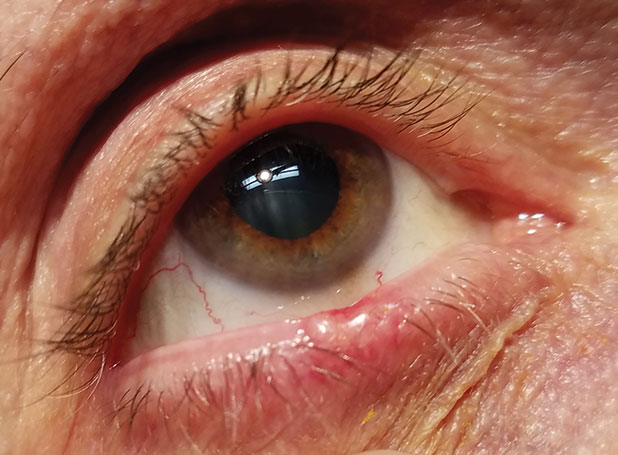 |
|
People who smoke are at higher risk of developing eyelid cancer. Photo: Sara Weidmayer, OD. Click image to enlarge. |
Recent research estimating the prevalence of eyelid cancers in the American Academy of Ophthalmology IRIS Registry and examining associated factors revealed a previously unreported association between active smoking and eyelid cancer as well as specific subtypes, including basal cell carcinoma (BCC), squamous cell carcinoma (SCC) and malignant melanoma (MM).
The retrospective study enrolled patients in the IRIS Registry with ICD-9/10 codes for eyelid cancers. These included BCC, SCC, MM, sebaceous carcinoma/other specified malignant neoplasm (SBC), melanoma in-situ (MIS) and unspecified malignant neoplasm (UMN).
The researchers estimated overall prevalence for each cancer type as well as age group, sex, race, ethnicity and smoking status. They used univariable and multivariable logistic regression models to examine associations between any eyelid cancer or each cancer type as well as possible risk factors.
In this analysis, 82,136 patients with eyelid cancer were identified. Data showed that the prevalence of any eyelid cancer was 145.1 per 100,000 people. The following cancer-specific prevalence per 100,000 people was reported: 87.9 (BCC), 25.6 (UMN), 11.1 (SCC), 5.0 (SBC), 4.1 (MM) and 0.4 (MIS).
The study authors observed that the prevalence increased with older age for any eyelid cancer as well as for each cancer type. They also found a higher prevalence among males for any eyelid cancer and BCC, SCC, MM and MIS. Compared with other races, prevalence was highest in whites for BCC, SCC, MM, SBC and any eyelid cancer.
A multivariable logistic regression model with associated risk factors revealed that any eyelid cancer was associated with older age groups, male sex and white race. Additionally, active smoking was correlated with any eyelid cancer, BCC, SCC and MM.
“Our findings support that BCC is the most common eyelid cancer in the United States representing 61% of all eyelid cancers. This study also showed that eyelid cancers were associated with older age group, particularly those >60 years of age, male sex and white race,” the study authors concluded in their recent Ophthalmology Science paper. “Healthcare providers should maintain a high index of suspicion for possible eyelid cancer when examining high-risk patients, such as older white non-Hispanic men who are active smokers. These data could additionally aid in earlier detection and planning of future healthcare policies for eyelid cancer prevention.”
Baş Z, Sharpe J, Yaghy A, et al. Eyelid cancer prevalence and associated factors in the American Academy of Ophthalmology IRIS Registry. Ophthalmology. September 27, 2022. Epub ahead of print. |

